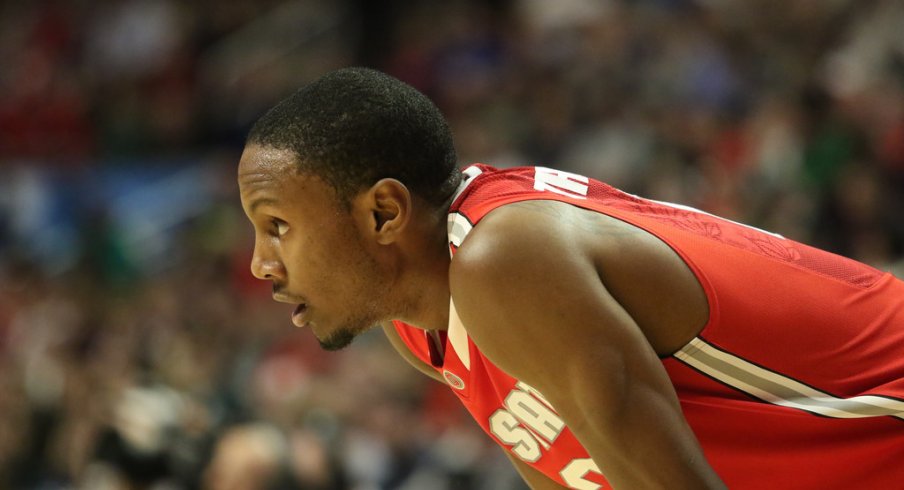The last couple of seasons have been trying for Ohio State basketball fans – well, as trying as a 49-21 record and two NCAA Tournament appearances can be.
Ohio State's loss to Arizona on Saturday was a sort of Rorschach test for fans, one that reinforced what many believed about Buckeye basketball. As the final buzzer sounded and Ohio State headed back to the locker room, one thought was common to optimists and pessimists alike: I expected this.
If you were happy with Ohio State's performance, you noticed how a 2-3 zone stymied the Wildcats for an entire half, how Amir Williams and Trey McDonald played with fire in their bellies, how Sam Thompson made two (!) three-pointers. The Buckeyes held Arizona to 36 percent shooting from the floor, and if things had gone just a bit differently they would be in the Sweet 16.
If you were angry with Ohio State's performance, you too can see the glass as half-empty. The Buckeyes were gifted with an unusually poor shooting performance by Arizona, and proceeded to do nothing with it. Ohio State's largest lead was six (23-17, 5:25 left in the first half), and by that point it should have been a 16 point lead. Shannon Scott was error-prone when Ohio State needed a solid hand, and D'Angelo Russell had his worst shooting performance of the year when the Buckeyes could least afford it.
Expectations for this 2014-15 Ohio State basketball team have been all over the place. At various points this season, Ohio State had been projected as a four-seed or out of the NCAA Tournament altogether. The Buckeyes received the benefit of the doubt, usually. Given the variety in projections, a round of 32 exit seems appropriate.
Ohio State is in a state of flux for 2015-16. Five seniors are leaving, and if D'Angelo Russell declares for the NBA Draft as expected, the Buckeyes will have to replace 66.3 percent of this team's minutes. Next year could be ugly, and other programs in Ohio are suited to pick up if Ohio State suffers a downturn.
There are three schools in Ohio with strong basketball prestige besides Ohio State: Cincinnati, Xavier and Dayton. Each made the round of 32 this year, and each stands to benefit if Ohio State drops off next year.
Cincinnati would rather not be in the American Athletic Conference; even so, it is making the most of the situation. Head coach Mick Cronin had to serve in an advisory role this season because of poor health, but interim coach Larry Davis guided the Bearcats to a 23-11 record and an eight-seed.
In the first round of the tournament, Cincinnati came back from a late deficit to knock off Purdue in overtime, 66-65. The Bearcats knew facing Kentucky in the round of 32 would be hopeless, but they did everything in their power to win. With tough interior play, Cincinnati actually led the Wildcats for most of the first half. Even though they eventually lost by 13, the Bearcats hung around long enough to turn the 10,000 Kentucky fans in attendance into foul conspiracy theorists.
Cincinnati loses only one rotation player in 2016, and it will have a strong senior presence. If the performances of Octavius Ellis and Coreontae DeBerry against Kentucky are any indication, they will be tough to beat on the interior. Cincinnati has made the last five NCAA Tournaments, and they could make noise next year.
Xavier, one of two Ohio teams still playing in the NCAA Tournament, knows about consistency. The Musketeers have made the Sweet 16 in five of the last eight years, a remarkable feat for a private school with 4,652 undergrads. Xavier survived a brutal schedule, going 22-13 in the Big East and securing a six-seed. The Musketeers defeated Ole Miss and Georgia State to reach the Sweet 16, where they will face Arizona.
Win or lose, Xavier ought to be good next year; it loses power forward Matt Stainbrook as well as point guard Dee Davis, but it gets to keep Big East All-Rookie Team forward Trevon Bluiett. With six freshmen on the 2015 team, Xavier coach Chris Mack's 2016 team ought to be more mature.
Dayton is the only Ohio team yet to play its second round game, but the odds of advancing look good for the Flyers. After a run to the finals of the Atlantic 10 Tournament, Dayton was widely assumed to be a 9 or 10 seed -- but the Selection Committee had them as the last team in the field.
The Flyers held off Boise State at UD Arena in Dayton, then made a short trek to Columbus to knock off six-seed Providence. They have another de facto home game against three-seed Oklahoma in the round of 32, which has prompted grumbling. Even so, they have made the most of being underseeded.
Next year, Dayton loses the biggest part of its offense, former Buckeye Jordan Sibert, but retains everyone else. Kendall Pollard, Dyshawn Pierre and the delightfully named Scoochie Smith will pace the Flyers, and they bring in four freshman for next season. Though Sibert is a big loss, Dayton could be dancing again in 2016.
Those three schools, as well the occasional MAC school, represent Ohio State's local challengers. Big Ten schools may be more frequent rivals in recruiting, but those are the next-tier schools for the Buckeyes to worry about.
Ohio State has too many resources to be down long, and the Buckeyes will never be bad as long as Thad Matta is around. Even so, this is a time of danger for the Ohio State program. Other teams are poised to capitalize on weakness, and the Buckeyes have yet to rebound.


